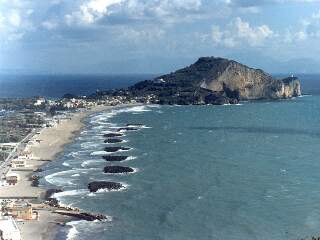Spring 2014 -- Pompeii, Vesuvius, and All That
ALRI Course #348
Ten two hour sessions -- Fridays, March 7 through May 9
Classes will begin at 930 AM and will last for two hours. Classes will be held at the George mason University Campus.
Click for enlarged view of the map


Course introduction:
Capo Miseno today.
-->
Pliny's HQ was on the
peak of the hill, from
which he could view all
of the Bay of Naples.
Pliny's HQ was on the
peak of the hill, from
which he could view all
of the Bay of Naples.
Naples Bay, Misenum Naval Base, 79 AD -- Pliny the Elder, an acute observer of natural phenomena, had already noted the ripples on the surface of the wine in his glass; the earth was shaking under his naval headquarters on the northern edge of the Bay of Naples. Ancient Greek and Roman historians and naturalists had, for a long time, warned of the fires under the volcano and described the charred rocks around its peak. Local mythology warned that a giant was buried under the mountain -- the brother of the more active giant trapped under Mount Etna in Sicily -- and warned that both were struggling to get out.
There had been massive eruptions centuries and millennia before; the whole of the Bay of Naples is but one-fourth of the huge caldera, and Vesuvius is only a small vent on its edge. But residents and ancient Roman vacationers and tourists in the towns clustered around the base of Vesuvius were not aware of the significance of the early warning signs. In fact many in Pompeii even had forgotten their local mythology and religion. They had turned to the worship of an Egyptian Goddess, Isis, who apparently knew nothing of volcanoes.
On August 24, 79 AD, they briefly had cause to regret what they had forgotten. Their regrets were brief, because the next day they were dead. Thousands of bodies have been recovered since those two days, and many more thousands (the folks that fled the towns) are still out there in the unexcavated countryside under thick layers of ash and clasts.
Our class will look at the geology and history of the area around the Neapolitan caldera and then at the 79 AD eruption and its aftermath. We will explore the ruins and see the recovered artifacts. We'll read the eyewitness description of the eruption written by Pliny the Younger, who declined the invitation to accompany his uncle, Pliny the Elder, on his fatal fact-finding and attempted rescue mission into the danger area. Even so, Pliny the Younger had to flee the final paroxysmal pyroclastic flow that roared almost 20 miles across the Bay of Naples.
There's much more: see http://www.mmdtkw.org/ALRItkwVesPompeiiVesuvius.html (which includes some suggested readings beyond the course handouts) and http://www.mmdtkw.org/ALRItkwPages.html#Vesuvius.
And be warned: Vesuvius is overdue for another major eruption.